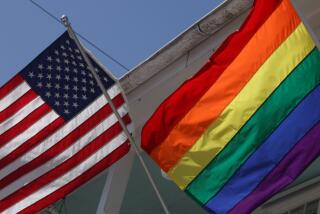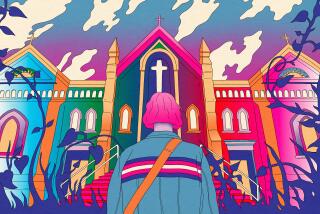Ex-Gay Basher Looks Back, Sees Real Fear of Own Homosexuality
- Share via
Michelangelo Signorile was 9 when his ears first burned with the jeers “sissy” and “queer” from his New York schoolmates. Scared the taunts were true, he turned his fear and fury on other outcast boys.
“I became a queer-basher to prove I wasn’t queer,” Signorile writes in his book, “Queer in America.”
“You’d make sure to do it in front of everyone . . . to show everyone else you were macho,” Signorile said, describing how he punched and pummeled his victims. “But I think also it was showing yourself.”
Eventually, Signorile, a 32-year-old writer best known for “outing” famous but closeted gays, accepted that he was gay.
But until the age of 17, the threat of ostracism and fright at his budding homosexuality turned Signorile into a schoolyard gay basher--two reasons among many that psychologists suggest to explain anti-gay violence.
Research into such violence is as scant as reports of the incidents themselves. What informs the experts is a mix of observation, experience, educated assumptions and common sense.
Gregory M. Herek, a social psychologist at the University of California at Davis who is widely ranked as the nation’s leading expert on anti-gay violence, describes a knot of reasons why homosexuals are targeted.
The clots of young men who visit gay neighborhoods to pounce on homosexuals may hope to prove they belong in their peer group of “real men.”
Those who target lesbians feel affronted by women who don’t appear to need men, even as objects of sexual desire.
In a society inured and secretly--and not so secretly--excited by violence, the roughing up of homosexuals may seem appropriate.
Gay bashers may be acting on sexual confusion, unsettled by any attraction to their own sex and lacking understanding about sexuality.
Among young men, especially, there’s a strong need to prove themselves and to forge bonds, Herek said.
“The teens and early 20s is a time of identity consolidation, struggling with issues of manhood and masculinity, how one becomes a man,” he said. “By attacking a gay man or a lesbian, these guys are trying symbolically to affirm their manhood.”
Gay bashing can be a way of expressing values, Herek said. “Like saying, ‘I’m a good person, I adhere to these values. I’m a good Christian, homosexuality is the devil and I’m going to attack this.’ ”
Plain old xenophobia, fear of strangers, may also be at work.
“The fact that (homosexuality) is uncommon, and therefore it’s strange, and if you, yourself . . . get a little excitement out of a same-sex person, this could be upsetting,” said Ray Bixler, psychology professor emeritus at the University of Louisville, an expert on gender differences in behavior.
Under the tangle of feelings that ignite gay bashers lies a hatred of women, suggests Matthew Weissman, a psychologist in Washington, D.C.
“We are a culture that fears and despises the feminine aspect of character,” Weissman said. The sticky stereotype of women as passive and weak gets attached to gay men, he said.
“I think for a lot of straight people, when they think a gay man may let himself be penetrated, it opens up fears among men about passive desires.”
All this, experts say, occurs at a time when American society seems hospitable to hate and derision directed at homosexuals.
“To the extent that we have in this culture . . . people espousing the notion that homosexuals are deviant, are less than fully human, then perhaps that contributes to an atmosphere where it’s thought somehow acceptable to harass and physically abuse them,” said Gene Nichols, dean of the law school at the University of Colorado in Boulder and chairman of a school task force that investigated anti-gay harassment and violence on its campus.
“The culture defines out-groups and acceptable targets,” said Herek, the social psychologist at the University of California.
“In times past, the members of out-groups would have been members of religions or racial groups. Today, lesbians and gay men seem to be the most prominent out-group in America.”
More to Read
Sign up for Essential California
The most important California stories and recommendations in your inbox every morning.
You may occasionally receive promotional content from the Los Angeles Times.










